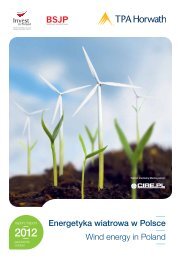Energetyka wiatrowa w Polsce Wind energy in Poland - TPA Horwath
Energetyka wiatrowa w Polsce Wind energy in Poland - TPA Horwath
Energetyka wiatrowa w Polsce Wind energy in Poland - TPA Horwath
Create successful ePaper yourself
Turn your PDF publications into a flip-book with our unique Google optimized e-Paper software.
62<br />
Germanischer Lloyd Garrad Hassan (GL GH)<br />
zapewnia wsparcie projektów wiatrowych na<br />
każdym etapie ich rozwoju, dlatego nasza<br />
firma ma możliwość obserwowania zmian<br />
zachodzących na rynku. Jednym z takich<br />
obserwowanych trendów jest zwiększenie<br />
za<strong>in</strong>teresowania prognozowaniem krótkoterm<strong>in</strong>owym<br />
(ang. „short-term forecast<strong>in</strong>g”),<br />
czyli najprościej mówiąc, przewidywaniem<br />
prędkości i kierunku wiatru, a co za tym<br />
idzie, także wielkości produkcji energii<br />
elektrycznej, którą wytworzy dana farma<br />
<strong>wiatrowa</strong>.<br />
Na wspomniany wzrost za<strong>in</strong>teresowania<br />
usługą wpływa co najmniej kilka istotnych<br />
czynników. Można tu wskazać przede<br />
wszystkim rosnącą moc źródeł wiatrowych<br />
przyłączanych do sieci energetycznej,<br />
a w konsekwencji zwiększający się wpływ,<br />
jaki owe źródła mogą wywierać na sieć.<br />
Z kwestią wpływu na sieć wiąże się również<br />
fakt, że operatorzy systemów energetycznych<br />
coraz częściej wymagają dostarczania<br />
miarodajnych danych prognostycznych,<br />
dotyczących przyłączonych elektrowni<br />
wiatrowych. Dzięki temu możliwe jest właściwe zarządzanie<br />
<strong>in</strong>nymi <strong>in</strong>stalacjami wytwórczymi (takimi jak elektrownie<br />
konwencjonalne), jak i samym systemem przesyłowym.<br />
Dodatkowo, zwiększająca się świadomość możliwości,<br />
jakie daje prognozowanie sprawia, że właściciele dostrzegają<br />
możliwości bardziej efektywnego wykorzystania dostępnego<br />
potencjału wiatru, na przykład w kontekście planowania<br />
serwisów czy przeglądów. Oczywistą sprawą jest, że w <strong>in</strong>teresie<br />
właściciela leży takie zaplanowanie tych robót, aby<br />
związane z nimi straty produkcji, a więc i przychodu, były<br />
jak najmniejsze. Dlatego, najbardziej logicznym rozwiązaniem<br />
jest prowadzenie prac wymagających wyłączenia<br />
turb<strong>in</strong>y w okresach o niskiej wietrzności. Nie sposób także<br />
nie wspomnieć o czynnikach ekonomicznych, gdyż prognozowanie<br />
może być także szansą na zwiększenie dochodu<br />
operatora farmy wiatrowej (poprzez przejście z modelu sprzedaży<br />
energii, opartego o umowę długoterm<strong>in</strong>ową, na obrót<br />
na towarowej giełdzie energii), co jest bardzo istotne w obecnych,<br />
coraz trudniejszych warunkach rynkowych.<br />
Profesjonalna prognozowanie opiera się na wielu elementach,<br />
takich jak różnorodne numeryczne modele meteorologiczne<br />
i dane operacyjne. Prognoza pow<strong>in</strong>na uwzględniać<br />
nie tylko warunki meteorologiczne na danym obszarze, ale<br />
również lokalne warunki terenowe, układ farmy wiatrowej czy<br />
rodzaj i parametry zastosowanych turb<strong>in</strong>. Końcowym efektem<br />
prognozowania jest przedstawienie spodziewanych wartości<br />
produkcji energii w nadchodzącym okresie, wraz z określeniem<br />
poziomu niepewności prognozy.<br />
Podsumowując, nowoczesne techniki prognozowania krótkoterm<strong>in</strong>owego<br />
mogą być bardzo użyteczne dla wszystkich<br />
uczestników rynku energetyki wiatrowej – właścicieli projektów<br />
i zarządzających farmami, przedsiębiorstw energetycznych,<br />
operatorów sieci, czy podmiotów f<strong>in</strong>ansujących. Dlatego<br />
wydaje się, że warto za<strong>in</strong>teresować się zagadnieniami związanymi<br />
z prognozowaniem krótkoterm<strong>in</strong>owym, gdyż związane<br />
z nim korzyści mogą być zarówno praktyczne, jak i bardzo<br />
wymierne.<br />
<strong>Energetyka</strong> <strong>wiatrowa</strong> w <strong>Polsce</strong> / <strong>W<strong>in</strong>d</strong> <strong>energy</strong> <strong>in</strong> <strong>Poland</strong><br />
Łukasz Sikorski<br />
Independent Eng<strong>in</strong>eer<strong>in</strong>g Group,<br />
GL Garrad Hassan<br />
Germanisher Lloyd Garrad Hassan (GL<br />
GH) is provid<strong>in</strong>g support at every stage<br />
of the development and operation of<br />
w<strong>in</strong>d projects. It therefore has an unique<br />
<strong>in</strong>sight <strong>in</strong>to the changes that are occurr<strong>in</strong>g<br />
<strong>in</strong> the market. One of the trends recently<br />
observed is a grow<strong>in</strong>g <strong>in</strong>terest <strong>in</strong> shortterm<br />
forecast<strong>in</strong>g, a technique which could<br />
be def<strong>in</strong>ed as predict<strong>in</strong>g w<strong>in</strong>d speed and<br />
its direction <strong>in</strong> order to produce electricity<br />
production forecasts for any given w<strong>in</strong>d<br />
farm.<br />
The afore-mentioned ris<strong>in</strong>g <strong>in</strong>terest <strong>in</strong><br />
forecast<strong>in</strong>g services could be occurr<strong>in</strong>g<br />
for a number of important reasons. First of<br />
all, the amount of w<strong>in</strong>d generated power<br />
connected to the gird is still <strong>in</strong>creas<strong>in</strong>g,<br />
so the impact which w<strong>in</strong>d generation<br />
has on the electric power system is also<br />
<strong>in</strong>creas<strong>in</strong>g. As this <strong>in</strong>fluence is becom<strong>in</strong>g<br />
more and more significant, power<br />
operators are more often demand<strong>in</strong>g<br />
reliable forecast<strong>in</strong>g <strong>in</strong>formation concern<strong>in</strong>g<br />
w<strong>in</strong>d farms that are connected to the<br />
grid. Thanks to this, other generation<br />
<strong>in</strong>stallations (such as conventional power plants and<br />
the distribution grid itself) could be properly managed.<br />
Additionally, w<strong>in</strong>d farm owners’ grow<strong>in</strong>g awareness of how<br />
forecast<strong>in</strong>g could allow w<strong>in</strong>d potential to be harnessed<br />
efficiently means that forecast<strong>in</strong>g methods are <strong>in</strong>creas<strong>in</strong>gly<br />
be<strong>in</strong>g used as tools for the schedul<strong>in</strong>g of ma<strong>in</strong>tenance<br />
and servic<strong>in</strong>g works. It is obvious that it is <strong>in</strong> the w<strong>in</strong>d farm<br />
owner’s <strong>in</strong>terests to plan works <strong>in</strong> a manner that ensures<br />
m<strong>in</strong>imum production (and <strong>in</strong>come) losses. Therefore, the<br />
most logical solution is to carry out works that require<br />
the turb<strong>in</strong>es to be switched off dur<strong>in</strong>g low w<strong>in</strong>d periods.<br />
Economical issues are also a factor, as forecast<strong>in</strong>g is<br />
also a chance to <strong>in</strong>crease w<strong>in</strong>d farm owners’ <strong>in</strong>comes<br />
(achieved by sell<strong>in</strong>g the produced electricity on the <strong>energy</strong><br />
trad<strong>in</strong>g market rather than via a long-term bilateral power<br />
purchase agreement), which is very important consider<strong>in</strong>g<br />
the currently hostile market conditions.<br />
Professional forecast is based on multiple elements,<br />
such as different numerical meteorological models and<br />
operational data. Furthermore, a proper forecast should<br />
consider not only the meteorological conditions <strong>in</strong> the w<strong>in</strong>d<br />
farm area, but also the terra<strong>in</strong> conditions, turb<strong>in</strong>e layout(s)<br />
and type(s), and the parameters of the <strong>in</strong>stalled turb<strong>in</strong>es.<br />
The f<strong>in</strong>al forecast<strong>in</strong>g result is of course the presentation of<br />
expected values of <strong>energy</strong> production <strong>in</strong> the forthcom<strong>in</strong>g<br />
period, together with a description of the uncerta<strong>in</strong>ty of<br />
such a prediction.<br />
To conclude, the state of the art short-term forecast<strong>in</strong>g<br />
techniques could be very useful for all the parties engaged<br />
<strong>in</strong> the w<strong>in</strong>d <strong>energy</strong> market – project owners, w<strong>in</strong>d farm<br />
managers, power utilities, grid operators or lend<strong>in</strong>g<br />
<strong>in</strong>stitutions. Therefore, short-term forecast<strong>in</strong>g is someth<strong>in</strong>g<br />
worth focuss<strong>in</strong>g on, as it could result <strong>in</strong> both practical and<br />
measurable f<strong>in</strong>ancial benefits.



